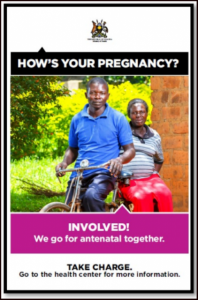Communication for Healthy Communities, Uganda
This program, funded by USAID and managed by FHI360 (2013-2018), was designed to help reduce high national rates of HIV infection, total fertility, maternal and child mortality, malnutrition, malaria and tuberculosis (TB).
The program worked to achieve these objectives by increasing the adoption of healthy behaviors — including an uptake of critical health services — through strengthened health communications and by:
- Designing and implementing high-quality health communication interventions to improve knowledge, attitudes, norms, behaviors and demand for services related to HIV, TB, malaria, nutrition, maternal and child health and family planning
- Improving the coordination of health communications interventions
- Increasing research and knowledge management to enhance health communications
In partnership with the Uganda Health Marketing Group, FHI 360 worked across the country to advance the skills needed to design, manage and evaluate health communications interventions, and to adapt and scale up communications efforts in support of service delivery activities at the community level. CHC supported a robust learning agenda that strengthened program implementation, documented impact and contributed to the SBC knowledge base. CHC also enhanced the Government of Uganda’s capacity to lead and coordinate similar SBC interventions.
“Oblulamu” Integrated Life-cycle Based Health Campaign
Running from September 2014 to December 2017, and then 2013-2020, and implemented by the Communication for Healthy Communities Project the Oblulamu Campaign was managed by FHI360. It forms a multi-channel communication platform using the standard greeting “How’s Life” as its umbrella slogan to integrate six health areas: HIV/AIDS, family planning, malaria, maternal and child health, nutrition and TB. The campaign uses radio, television, and print materials which can be used and adapted by campaign partners. The campaign is a series of innovative health communication interventions. The Oblulamu campaign was designed in four phases that follow a life-stage approach for audience focus.
Source: USAID, FHI360
Date of Publication: May 19, 2020
SIMILIAR RESOURCES
Tools
Examples
- Accelerator Behaviors
- The Behavior Change Framework
- HIV and Sexual and Reproductive Health Programming: Innovative Approaches to Integrated Service Delivery
- Integrated SBCC Programs: Key Challenges and Promising Strategies - Webinar
- SBCC for Malaria in Pregnancy: Strategy Development Guidance
- Lever les Tabous: La sexualité et les approches promouvant l’égalité des genres pour mettre fin aux unions et aux mariages d’enfants, précoces et forcés
- Prioritizing and Targeting SBC Investments for Youth
- Using Data to Design an Evidence-based Social and Behavior Change Program in Rural Nepal
- Community Communication MNCH e-Manual: Participatory Health Promotion Sessions
- Nutrition Critical: Why We Must Act Now to Tackle Child Malnutrition

